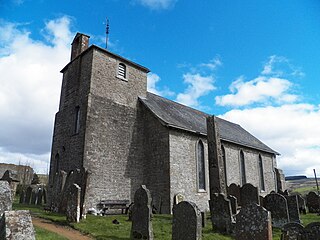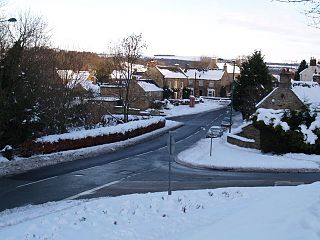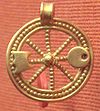Related Research Articles

Silvanus was a Roman tutelary deity of woods and uncultivated lands. As protector of the forest, he especially presided over plantations and delighted in trees growing wild. He is also described as a god watching over the fields and husbandmen, protecting in particular the boundaries of fields. The similarly named Etruscan deity Selvans may be a borrowing of Silvanus, or not even related in origin.

Belatucadros or Belatucadrus, was a deity worshipped in Celtic northern Britain, particularly in Cumberland and Westmorland. In the Roman period he was identified with Mars and appears to have been worshipped by lower-ranked Roman soldiers as well as by Britons. In five inscriptions he is called Mars Belatucadrus and the name is frequently translated as "fair shining one" or "fair slayer."
In Celtic mythology, Clṻd /klɨːd/ or Clọ:tā /klɔːtaː/ is a hypothesised/inferred Brittonic goddess of the River Clyde. If she was ever revered historically, she would presumably have been worshipped by the Damnonii tribe who held the territory around the Clyde basin which later was to become the Kingdom of Alt Clud, at least prior to the Christianisation of Roman Britain and possibly later.
In Gallo-Roman religion, Segomo was a war god worshipped in Gaul. In Roman times he was equated with Mars and Hercules. He may be related to Cocidius, a similar god worshipped in Britain. The name of the legendary High King of Ireland Nia Segamain, which translates as "sister's son or champion of Segamon", may be related.
In Romano-British culture and Germanic polytheism, the Alaisiagae were a quartet of Celtic and Germanic goddesses deifying victory.

Ancient Celtic religion, commonly known as Celtic paganism, was the religion of the ancient Celtic peoples of Europe. Because there are no extant native records of their beliefs, evidence about their religion is gleaned from archaeology, Greco-Roman accounts, and literature from the early Christian period. Celtic paganism was one of a larger group of polytheistic Indo-European religions of Iron Age Europe.
Veteris was a Celtic god attested from many inscriptions in Roman Britain. The dedicants were usually private individuals and were exclusively male. During the 3rd Century AD the cult was particularly popular among the ranks of the Roman army.
Verostonos was a god in ancient Celtic polytheism, worshipped in Roman Britain. His name links him to alder-trees. Altar-stones raised to him have been recovered in the United Kingdom, such as that at Ebchester in County Durham . His association with Cocidius in that inscription suggests that he may have been linked with, or an epithet of, that more widely attested war god.

Gallo-Roman religion is a fusion of the traditional religious practices of the Gauls, who were originally Celtic speakers, and the Roman and Hellenistic religions introduced to the region under Roman Imperial rule. It was the result of selective acculturation.

Bewcastle is a large civil parish in the Cumberland unitary authority area of Cumbria, England. It is in the historic county of Cumberland.

Cantabrian mythology refers to the myths, teachings and legends of the Cantabri, a pre-Roman Celtic people of the north coastal region of Iberia (Spain). Over time, Cantabrian mythology was likely diluted by Celtic mythology and Roman mythology with some original meanings lost. Later, the ascendancy of Christendom absorbed or ended the pagan rites of Cantabrian, Celtic and Roman mythology leading to a syncretism. Some relics of Cantabrian mythology remain.

Vindomora was an auxiliary fort on Dere Street, in the province of Lower Britain. Its ruins, now known as Ebchester Roman Fort, are situated at Ebchester in the English county of Durham, to the north of Consett and 12 miles (19 km) west-south-west from Newcastle upon Tyne.

Aballava or Aballaba was a Roman fort on Hadrian's Wall, between Petriana (Stanwix) to the east and Coggabata (Drumburgh) to the west. It is about one and a half miles south of the Solway Firth, and its purpose was to guard the south end of two important Solway fords, the Peat Wath and the Sandwath, which were also to become favourite routes for medieval border raiders.

Hadrian's Wall is a former defensive fortification of the Roman province of Britannia, begun in AD 122 in the reign of the Emperor Hadrian. Running from Wallsend on the River Tyne in the east to Bowness-on-Solway in the west of what is now northern England, it was a stone wall with large ditches in front and behind, stretching across the whole width of the island. Soldiers were garrisoned along the line of the wall in large forts, smaller milecastles, and intervening turrets. In addition to the wall's defensive military role, its gates may have been customs posts.

Bewcastle Roman Fort was built to the north of Hadrian's Wall as an outpost fort possibly intended for scouting and intelligence. The remains of the fort are situated at the village of Bewcastle, Cumbria, 7 miles (11 km) to the north of the Roman fort at Birdoswald, on Hadrian's Wall.

In ancient Roman religion and mythology, Mars is the god of war and also an agricultural guardian, a combination characteristic of early Rome. He is the son of Jupiter and Juno, and was pre-eminent among the Roman army's military gods. Most of his festivals were held in March, the month named for him, and in October, the months which traditionally began and ended the season for both military campaigning and farming.

The gods and goddesses of the pre-Christian Celtic peoples are known from a variety of sources, including ancient places of worship, statues, engravings, cult objects, and place or personal names. The ancient Celts appear to have had a pantheon of deities comparable to others in Indo-European religion, each linked to aspects of life and the natural world. Epona was an exception and retained without association with any Roman deity. By a process of syncretism, after the Roman conquest of Celtic areas, most of these became associated with their Roman equivalents, and their worship continued until Christianization. Pre-Roman Celtic art produced few images of deities, and these are hard to identify, lacking inscriptions, but in the post-conquest period many more images were made, some with inscriptions naming the deity. Most of the specific information we have therefore comes from Latin writers and the archaeology of the post-conquest period. More tentatively, links can be made between ancient Celtic deities and figures in early medieval Irish and Welsh literature, although all these works were produced well after Christianization.

The Waterloo Helmet is a pre-Roman Celtic bronze ceremonial horned helmet with repoussé decoration in the La Tène style, dating to circa 150–50 BC, that was found in 1868 in the River Thames by Waterloo Bridge in London, England. It is now on display at the British Museum in London.

Celtic mythology is the body of myths belonging to the Celtic peoples. Like other Iron Age Europeans, Celtic peoples followed a polytheistic religion, having many gods and goddesses. The mythologies of continental Celtic peoples, such as the Gauls and Celtiberians, did not survive their conquest by the Roman Empire, the loss of their Celtic languages and their subsequent conversion to Christianity. Only remnants are found in Greco-Roman sources and archaeology. Most surviving Celtic mythology belongs to the Insular Celtic peoples. They preserved some of their myths in oral lore, which were eventually written down by Christian scribes in the Middle Ages. Irish mythology has the largest written body of myths, followed by Welsh mythology.
Cohors PrimÆ Ælia Dacorvm was an infantry regiment of the Auxilia corps of the Imperial Roman army. It was first raised by the Roman emperor Hadrian in the Roman province of Dacia not later than AD 125 and its last surviving record dates c. 400. It was deployed, for virtually its entire history, in forts on Hadrian's Wall on the northern frontier of Britannia province.
References
- ↑ F. Guirand ed., New Larousse Encyclopedia of Mythology (London 1968) p. 237
- ↑ F. Guirand ed., New Larousse Encyclopedia of Mythology (London 1968) p. 243
- ↑ William Atkins, The Moor (London 2014) p. 323
- ↑ A.L.F. Rivet and C. Smith (1979), Place Names of Roman Britain.
- ↑ William Atkins, The Moor (London 2014) p. 322
- ↑ Togidumnus (4 March 2011). "Fanum Cocidi" . Retrieved 31 October 2013.
- ↑ Carving of 'northern god' found BBC NEWS Online, Published Saturday, 11 March 2006. Accessed Online May 14, 2015
- ↑ Barnett, T. (2006). Gods on the Rocks. Current Archaeology204: 618.
- ↑ Young, William A. (2022), The Ghosts of the Forest: The Lost Mythology of the North, Inter-Celtic, pp. 336 - 339, 431 - 459, ISBN 9781399920223

